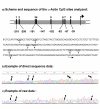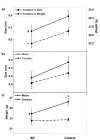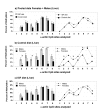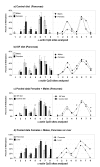Epigenetic and phenotypic changes result from a continuous pre and post natal dietary exposure to phytoestrogens in an experimental population of mice
- PMID: 18793434
- PMCID: PMC2556694
- DOI: 10.1186/1472-6793-8-17
Epigenetic and phenotypic changes result from a continuous pre and post natal dietary exposure to phytoestrogens in an experimental population of mice
Abstract
Background: Developmental effects of exposure to endocrine disruptors can influence adult characters in mammals, but could also have evolutionary consequences. The aim of this study was to simulate an environmental exposure of an experimental population of mice to high amounts of nutritional phytoestrogens and to evaluate parameters of relevance for evolutionary change in the offspring. The effect of a continuous pre- and post-natal exposure to high levels of dietary isoflavones was evaluated on sexual maturity, morphometric parameters and DNA methylation status in mice. Adult mice male/female couples were fed ad libitum either with control diet (standard laboratory chow) or ISF diet (control diet plus a soy isoflavone extract at 2% (w/w) that contained the phytoestrogens genistein and daidzein). In the offspring we measured: i) the onset of vaginal opening (sexual maturation) in females, ii) weight and size in all pups at 7, 14, 21 and 42 days post-natal (dpn) and iii) DNA methylation patterns in skeletal alpha-actin (Acta1), estrogen receptor-alpha and c-fos in adults (42 dpn).
Results: Vaginal opening was advanced in female pups in the ISF group, from 31.6 +/- 0.75 dpn to 25.7 +/- 0.48. No differences in size or weight at ages 7, 14 or 21 dpn were detected between experimental groups. Nevertheless, at age 42 dpn reduced size and weight were observed in ISF pups, in addition to suppression of normal gender differences in weight seen in the control group (males heavier that females). Also, natural differences seen in DNA methylation at Acta1 promoter in the offspring originated in the control group were suppressed in the ISF group. Acta1 is known to be developmentally regulated and related to morphomotric features.
Conclusion: This study demonstrates in mammals that individuals from a population subjected to a high consumption of isoflavones can show alterations in characters that may be of importance from an evolutionary perspective, such as epigenetic and morphometric characters or sexual maturation, a life history character.
Figures









References
-
- Futuyma D, Moreno G. The evolution of ecological specialization. Annu Rev Ecol Syst. 1988;19:201–233.
-
- Oster G, Alberch P. Evolution and bifurcation of developmental programs. Evolution. 1982;36:444–459. - PubMed
-
- Nijhout FH, Wray GA, Kremen C, Teragawa K. Ontogeny, phylogeny and evolution of form: an algorithmic approach. Syst Zool. 1986;35:445–457.
-
- Guerrero-Bosagna C, Sabat P, Valladares L. Environmental signaling and evolutionary change: can exposure of pregnant mammals to environmental estrogens lead to epigenetically induced evolutionary changes in embryos? Evol Dev. 2005;7:341–350. - PubMed
Publication types
MeSH terms
Substances
LinkOut - more resources
Full Text Sources

